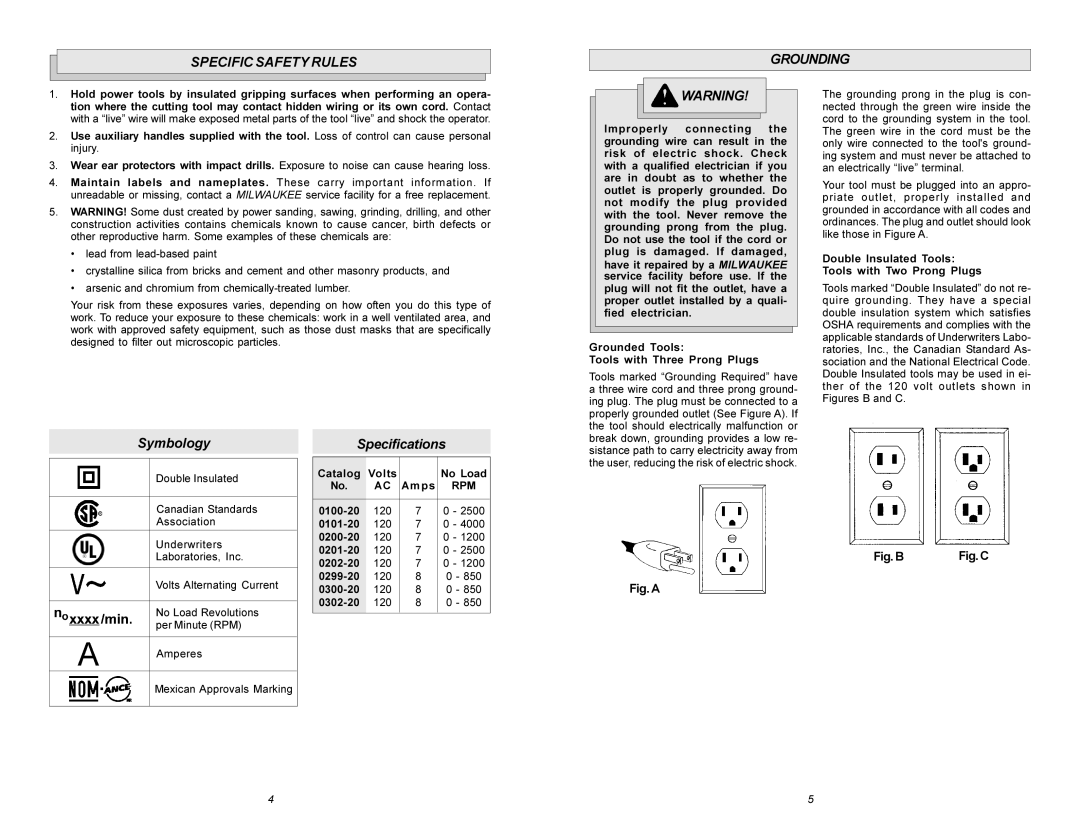
SPECIFIC SAFETY RULES
GROUNDING
1.Hold power tools by insulated gripping surfaces when performing an opera- tion where the cutting tool may contact hidden wiring or its own cord. Contact with a “live” wire will make exposed metal parts of the tool “live” and shock the operator.
2.Use auxiliary handles supplied with the tool. Loss of control can cause personal injury.
3.Wear ear protectors with impact drills. Exposure to noise can cause hearing loss.
4.Maintain labels and nameplates. These carry important information. If unreadable or missing, contact a MILWAUKEE service facility for a free replacement.
5.WARNING! Some dust created by power sanding, sawing, grinding, drilling, and other construction activities contains chemicals known to cause cancer, birth defects or other reproductive harm. Some examples of these chemicals are:
•lead from
•crystalline silica from bricks and cement and other masonry products, and
•arsenic and chromium from
Your risk from these exposures varies, depending on how often you do this type of work. To reduce your exposure to these chemicals: work in a well ventilated area, and work with approved safety equipment, such as those dust masks that are specifically designed to filter out microscopic particles.
![]()
![]()
![]()
![]() WARNING!
WARNING!
Improperly connecting the grounding wire can result in the risk of electric shock. Check with a qualified electrician if you are in doubt as to whether the outlet is properly grounded. Do not modify the plug provided with the tool. Never remove the grounding prong from the plug. Do not use the tool if the cord or plug is damaged. If damaged,
have it repaired by a MILWAUKEE service facility before use. If the plug will not fit the outlet, have a proper outlet installed by a quali- fied electrician.
Grounded Tools:
Tools with Three Prong Plugs
The grounding prong in the plug is con- nected through the green wire inside the cord to the grounding system in the tool. The green wire in the cord must be the only wire connected to the tool's ground- ing system and must never be attached to an electrically “live” terminal.
Your tool must be plugged into an appro- priate outlet, properly installed and grounded in accordance with all codes and ordinances. The plug and outlet should look like those in Figure A.
Double Insulated Tools: Tools with Two Prong Plugs
Tools marked “Double Insulated” do not re- quire grounding. They have a special double insulation system which satisfies OSHA requirements and complies with the applicable standards of Underwriters Labo- ratories, Inc., the Canadian Standard As- sociation and the National Electrical Code.
Symbology
Double Insulated
Canadian Standards Association
Specifications
Catalog | Volts | Amps | No Load |
No. | AC | RPM | |
|
|
|
|
| 120 | 7 | 0 - 2500 |
| 120 | 7 | 0 - 4000 |
| 120 | 7 | 0 - 1200 |
Tools marked “Grounding Required” have a three wire cord and three prong ground- ing plug. The plug must be connected to a properly grounded outlet (See Figure A). If the tool should electrically malfunction or break down, grounding provides a low re- sistance path to carry electricity away from the user, reducing the risk of electric shock.
Double Insulated tools may be used in ei- ther of the 120 volt outlets shown in Figures B and C.
Underwriters
Laboratories, Inc.
Volts Alternating Current
No Load Revolutions per Minute (RPM)
Amperes
Mexican Approvals Marking
120 | 7 | 0 - 2500 | |
120 | 7 | 0 - 1200 | |
120 | 8 | 0 - 850 | |
120 | 8 | 0 - 850 | |
120 | 8 | 0 - 850 |
Fig.B | Fig.C |
Fig.A
4 | 5 |
